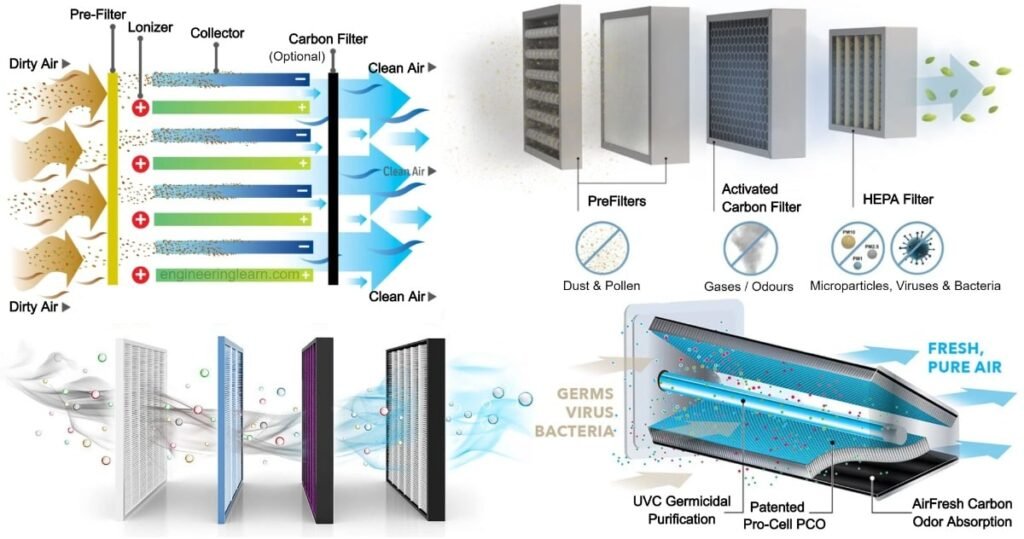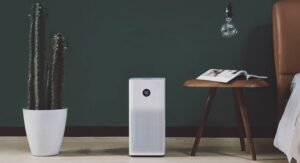There are several factors that need to consider before buying an air purifier but, you need to remember at least the most important points before buying an air purifier for your space. There is a long list of technical jargon and marketing gimmicks that might confuse you and you may end up buying the wrong one. We have done all the hard work to give you the right information and rescue you from wasting your time and money. Before buying an air purifier, here are some points to consider that you should definitely be aware of:
Clarify your needs:
- Purpose: Determine the reason why you need an air purifier. Do you need it to remove allergens, smoke, odors, or simply for better air quality?
- Room size: Determine the size of the room where you will be using the air purifier. Make sure to choose an air purifier that can handle the square footage of the room.
- Filter type: Look for air purifiers with HEPA filters that can remove small particles such as dust, pollen, and smoke from the air. Also, consider whether the filter needs to be replaced or can be cleaned.
- Noise level: Some air purifiers can be noisy, especially at higher fan speeds. If you plan to use it in a bedroom or other quiet area, consider the noise level.
- Energy efficiency: Look for an air purifier that is energy-efficient, so it won’t add too much to your electricity bill.
- Maintenance: Consider the maintenance required for the air purifier, such as filter replacement or cleaning, and factor in the cost and frequency.
- Price: Determine your budget and compare prices of air purifiers with similar features to make an informed decision.
By considering these points, you can choose an air purifier that best suits your needs and provides better air quality in your living space.
Choosing the right filtration system:

When choosing an air purifier, the filtration system is an important consideration as it directly affects the air quality in your home. Here are some factors to keep in mind when choosing the right filtration system:
- HEPA filter: Look for an air purifier with a High-Efficiency Particulate Air (HEPA) filter. These filters are designed to remove 99.97% of particles that are 0.3 microns or larger in size, including dust, pollen, mold, and pet dander. Ensure that the air purifier has a true HEPA filter, which is certified to meet HEPA standards.
- Activated carbon filter: An activated carbon filter can help remove odors, smoke, and volatile organic compounds (VOCs) from the air. This type of filter works by absorbing these particles into the carbon, which eliminates the odor or gas.
- Pre-filter: Many air purifiers have a pre-filter, which captures larger particles such as hair, lint, and pet fur. This pre-filter can help extend the life of the HEPA filter.
- UV-C light: Some air purifiers use ultraviolet (UV-C) light to kill bacteria and viruses in the air. However, UV-C light is not effective against all types of pollutants, so it should not be the only filtration method used.
- Size of the filtration system: The size of the filtration system is important to ensure that it can handle the size of the room where the air purifier will be used. Look for an air purifier with a filtration system that is appropriate for the square footage of the room.
By considering these factors, you can choose an air purifier with the right filtration system to ensure that your indoor air quality is improved and the air in your home is clean and healthy to breathe.
Two most important ratings ACH and CADR
When choosing an air purifier, two important ratings to consider are ACH and CADR.
ACH (Air Changes per Hour) is a measurement of how many times an air purifier can clean the air in a room in an hour. For example, an ACH rating of 5 means that the air purifier can clean the air in the room five times in one hour. A higher ACH rating indicates that the air in the room is being filtered more frequently and, therefore, is cleaner.
CADR (Clean Air Delivery Rate) is a measurement of an air purifier’s effectiveness in removing pollutants from the air. CADR measures the amount of clean air that an air purifier can deliver per minute, in relation to the size of the room. CADR ratings are provided for three types of pollutants: smoke, pollen, and dust. The higher the CADR rating, the more effective the air purifier is at removing that specific pollutant.
It is important to note that ACH and CADR ratings can vary depending on the size of the room and the level of pollutants in the air. Therefore, it is recommended to choose an air purifier with a higher ACH and CADR rating than the minimum recommended for your room size.
In summary, ACH and CADR ratings are both important when choosing an air purifier. A higher ACH rating indicates that the air in the room is being filtered more frequently, while a higher CADR rating indicates that the air purifier is more effective at removing pollutants from the air.
Noise Level and Energy Consumption of air purifier
When choosing an air purifier, it is important to consider its noise level and energy consumption to ensure that it will be suitable for your needs and budget.
Noise Level: Air purifiers can produce different levels of noise, depending on their fan speed and the type of motor they use. If you plan to use the air purifier in a bedroom or other quiet area, look for models with lower decibel ratings (dB) or that have a “silent” or “sleep” mode to reduce the noise level while still operating effectively.
Energy Consumption: Air purifiers can vary in their energy consumption, with some models using more electricity than others. Look for air purifiers with an Energy Star certification or that have a low wattage rating to ensure that they are energy-efficient and won’t add too much to your electricity bill.
Additionally, consider the size of the room where you will be using the air purifier. A larger room may require an air purifier with a higher fan speed, which can result in higher energy consumption and noise level. Conversely, a smaller room may only require a lower fan speed, which can result in a quieter and more energy-efficient operation.
In summary, when choosing an air purifier, consider its noise level and energy consumption to ensure that it is suitable for your needs and budget. Look for models with lower decibel ratings or silent/sleep modes, and with Energy Star certification or low wattage ratings to ensure that they are energy-efficient. Additionally, consider the size of the room and the required fan speed to balance the need for effective air cleaning with energy efficiency and noise level.
Cleaning Requirement and Maintenance Cost of air purifier
The cleaning requirement and maintenance cost of an air purifier will depend on the type and model of the purifier, as well as the frequency of use. Here are some general guidelines:
- Cleaning Requirement: Most air purifiers have a filter that needs to be replaced or cleaned periodically. The frequency of replacement/cleaning will depend on the type of filter, the size of the purifier, and the level of air pollution in your home.
HEPA filters typically need to be replaced every 6-12 months, depending on usage, while pre-filters and carbon filters may need to be cleaned or replaced more frequently. Some models have washable filters, while others require replacement.
It’s important to follow the manufacturer’s instructions for cleaning and replacing the filters, as well as the recommended schedule. Neglecting to clean or replace the filter can lead to reduced performance and poor air quality.
- Maintenance Cost: The maintenance cost of an air purifier will also depend on the type and model of the purifier. Some models have reusable filters that can be washed, which can save money in the long run. However, these models may have a higher upfront cost.
Other models require replacement filters, which can add up over time. The cost of replacement filters can vary widely, depending on the brand and type of filter. HEPA filters, for example, can be more expensive than other types of filters.
In addition to the cost of replacement filters, some models may require other maintenance, such as cleaning the unit or replacing the UV light bulb. These costs should also be taken into consideration when purchasing an air purifier.
Overall, it’s important to factor in both the cleaning requirement and maintenance cost when choosing an air purifier. Consider the size of the unit, the type of filter, and the recommended maintenance schedule to ensure that you can maintain good air quality without breaking the bank.
Smart Features (Optional)
Air purifiers with smart features have become increasingly popular, providing greater convenience and control for users. These features are good to have but not must to have. Here are some common smart features of air purifiers:
- WiFi Connectivity: Some air purifiers can connect to your home WiFi network, allowing you to control the purifier through a smartphone app. This feature allows you to adjust settings and monitor air quality from anywhere, as long as you have an internet connection.
- Voice Control: Air purifiers with voice control can be controlled through popular voice assistants such as Amazon Alexa or Google Assistant. This feature allows you to adjust settings or turn the purifier on or off using voice commands.
- Air Quality Monitoring: Some air purifiers have built-in sensors that monitor air quality levels and adjust settings accordingly. These sensors can detect the level of pollutants such as dust, pollen, and volatile organic compounds (VOCs), and automatically adjust fan speed or filtration settings to maintain good air quality.
- Auto Mode: With this feature, the air purifier can automatically adjust its settings based on the air quality readings. It may increase fan speed or activate additional filtration modes when air pollution levels are high, and reduce fan speed when the air quality is good.
- Filter Replacement Indicator: A filter replacement indicator notifies you when the filter needs to be replaced or cleaned, eliminating the guesswork and ensuring that the purifier continues to work effectively.
- App Notifications: Some air purifiers with smart features can send notifications to your smartphone when the filter needs to be replaced, the purifier needs to be cleaned, or the air quality drops below a certain level.
These smart features make it easier to maintain good air quality and provide greater convenience and control for users. When considering an air purifier, it’s important to evaluate the smart features to see which ones may be most useful for your needs.
Certifications and Warranty
Purchasing an air purifier with multiple certifications can increase its value. Certifications such as CARB, AHAM, Energy Star, and UL are common in the air purifier industry. Additionally, it’s recommended to choose a unit with a warranty of at least 1-2 years to ensure a worthwhile investment.
Navigating the air purifier market can be daunting due to the abundance of options. If you’re seeking a quick solution, we suggest browsing our list of top-rated air purifiers to maintain clean air in your home or office.




